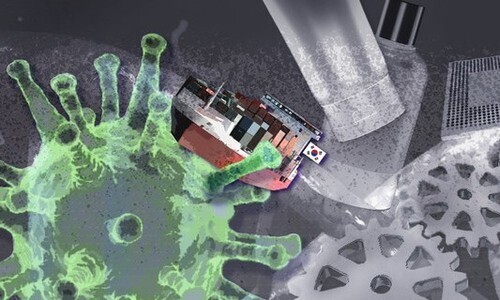hankyoreh
Links to other country sites 다른 나라 사이트 링크
S. Korean Q3 GDP growth rate rebounds to 1.9% after negative growth in Q1 and Q2

After suffering negative growth in the first and second quarters (Q1, Q2) of 2020 because of the COVID-19 pandemic, the South Korean economy succeeded in scoring a rebound in the third (Q3). But amid growing uncertainties with the virus’ strong resurgence in the US and Europe, analysts are saying it is too early to declare an economic recovery.
On Oct. 27, the Bank of Korea (BOK) announced that the real GDP growth rate (flash estimate) for Q3 was calculated as 1.9% compared with the previous quarter. The number is higher than the projections of South Korean and overseas securities companies (1.3-1.7%), as well as the “1.5%- growth rate range” named by BOK in August as necessary to achieve the annual economic growth target of -1.3%.
The rebound for the South Korean economy after suffering negative growth in Q1 (-1.3%) and Q2 (-3.2%) amid the pandemic’s shockwaves was attributed to the combination of a baseline effect from the steep Q2 drop and a sharp recovery in exports. Exports rose by 15.6% from Q2, with automobiles and semiconductors driving the trend. It was the largest percentage increase since the 18.4% recorded for Q1 1986.
“Because the Q2 growth rate was quite low, there definitely is something of a baseline effect operating here,” acknowledged Park Yang-su, head of BOK’s economic statistics department.
“Despite the intensified social distancing following the COVID-19 resurgence and worsening weather conditions with the monsoon season and typhoons, exports of goods have risen rapidly amid a recovery in global demand,” Park explained.
Imports also rose by 4.9%, mainly in the areas of crude oil and chemical products, while facility investment was up by 6.7% amid increases in the areas of machinery and transportation equipment. But private consumption was down 0.1% amid poor performance in apparel and other semi-durable goods, while construction investment slid by 7.8% amid a contraction in civil engineering and construction. By industry, manufacturing was up by 7.6% from the previous quarter, while agriculture, forestry, and fisheries were up by 1.8%. In the area of services, the increase amounted to 0.7%, pointing to a relatively weak recovery.
While the growth rate rebound for Q3 was larger than expected, BOK was very cautious about the future prospects for economic recovery. Park explained, “With the 1.9% rebound for the third quarter, there have been expectations that the actual annual growth rate will exceed BOK’s projection [-1.3%]. But if you take a conservative view that factors in risks such as the COVID-19 resurgence in Europe and the US, the annual growth rate still appears likely to fall within the range of that prediction.”
Park also stressed that the Q3 GDP was “still lower than for the same period same year,” adding that “we have no way of knowing yet whether the trend of increase will continue.”
“With recoveries slack for production in services like transportation and travel and for exports, we can’t reach any conclusions about a full recovery like the so-called ‘V-shaped’ rebound,” he added.
Speaking the same day, Deputy Prime Minister and Minister of Economy and Finance Hong Nam-ki said, “For the fourth quarter, the economic improvement is expected to continue, particularly in terms of domestic demand, following the downgrade to Level 1 disease control [measures].”
“But globally, there has been a serious resurgence of COVID-19, and uncertainties remain in terms of the US presidential election and US-China conflict,” he added.
By Shin Da-eun, staff reporter
Please direct comments or questions to [english@hani.co.kr]

Editorial・opinion
![[Column] Season 2 of special prosecutor probe may be coming to Korea soon [Column] Season 2 of special prosecutor probe may be coming to Korea soon](https://flexible.img.hani.co.kr/flexible/normal/500/300/imgdb/original/2024/0426/3317141030699447.jpg) [Column] Season 2 of special prosecutor probe may be coming to Korea soon
[Column] Season 2 of special prosecutor probe may be coming to Korea soon![[Column] Park Geun-hye déjà vu in Yoon Suk-yeol [Column] Park Geun-hye déjà vu in Yoon Suk-yeol](https://flexible.img.hani.co.kr/flexible/normal/500/300/imgdb/original/2024/0424/651713945113788.jpg) [Column] Park Geun-hye déjà vu in Yoon Suk-yeol
[Column] Park Geun-hye déjà vu in Yoon Suk-yeol- [Editorial] New weight of N. Korea’s nuclear threats makes dialogue all the more urgent
- [Guest essay] The real reason Korea’s new right wants to dub Rhee a founding father
- [Column] ‘Choson’: Is it time we start referring to N. Korea in its own terms?
- [Editorial] Japan’s rewriting of history with Korea has gone too far
- [Column] The president’s questionable capacity for dialogue
- [Column] Are chaebol firms just pizza pies for families to divvy up as they please?
- [Column] Has Korea, too, crossed the Rubicon on China?
- [Correspondent’s column] In Japan’s alliance with US, echoes of its past alliances with UK
Most viewed articles
- 1[Column] Season 2 of special prosecutor probe may be coming to Korea soon
- 2‘We must say no’: Seoul defense chief on Korean, USFK involvement in hypothetical Taiwan crisis
- 3Is N. Korea threatening to test nukes in response to possible new US-led sanctions body?
- 4Division commander ordered troops to enter raging flood waters before Marine died, survivor says
- 5Amnesty notes ‘erosion’ of freedom of expression in Korea in annual human rights report
- 6Is Japan about to snatch control of Line messenger from Korea’s Naver?
- 7No good, very bad game for Korea puts it out of Olympics for first time since 1988
- 8[Editorial] Korea’s surprise Q1 growth requires objective assessment, not blind fanfare
- 9N. Korean delegation’s trip to Iran shows how Pyongyang is leveraging ties with Moscow
- 10Korea’s 1.3% growth in Q1 signals ‘textbook’ return to growth, says government